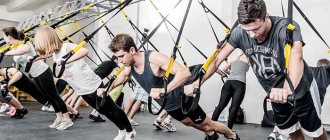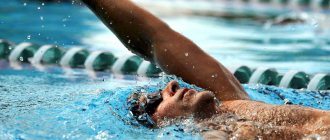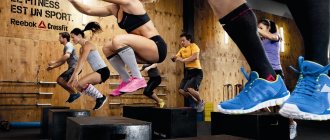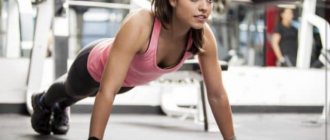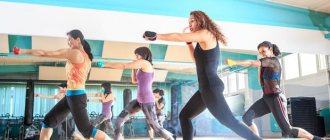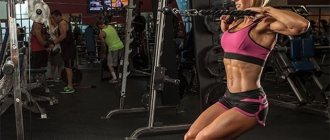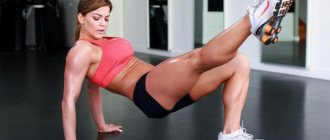Functional training gives you every opportunity to get an attractive, physically developed body. The program helps increase mobility, flexibility, and helps prevent household injuries. The effectiveness of exercise does not depend on where you practice. Even alone, in an apartment you can achieve excellent results. This does not require complex equipment; simple devices are sufficient. The exercises are often performed with your own body weight.
The program includes exercises for different muscle groups, you can perform them to rhythmic music. Functional fitness is extremely diverse in terms of load range and selection of exercises. These include squats, deadlifts, push-ups, and pull-ups. Movements are performed in different planes. The system also includes various jumps, lunges, and planks.
Exercises are combined into several cycles to increase endurance. The classes are easy to diversify and complicate. To do this, use a horizontal bar and parallel bars, elements with a barbell, weights, and cardio equipment.
What are the benefits of functional training?
- The technique harmoniously develops physical qualities - strength, strength endurance, speed, mobility, coordination.
- Proportionally strengthens the muscles.
- Improves the proportions of the figure, forms a strong, athletically developed body - as a result of exercise, fat is burned and aesthetic muscles appear.
- Speeds up metabolism, improves health.
- During training, stabilizer muscles that are not involved in other areas of fitness are well loaded.
Functional training refers to those rare programs that work stabilizing muscles and specific muscle groups that are passive in everyday life. This effect is achieved due to the special biomechanics of multi-joint exercises.
What sports qualities does functional training develop?
Bodyweight exercises improve strength:
- muscles become more developed, resilient and strong;
- different muscle groups work more harmoniously and economically, efficiency of movements is achieved;
- Stabilizing muscles are well developed and trained, as a result the musculoskeletal system is better protected from injury.
During training, speed and reaction indicators improve. The movements are performed using a high-speed, “explosive” technique. The heart, blood vessels, and respiratory system become resilient. Their safety margin and adaptive capabilities increase.
The “circular” or interval method has a positive effect on the body’s endurance and makes it easier to cope with any load. Favorable changes are also manifested in flexibility - joints and muscles become more elastic, and overall healthy mobility and mobility are achieved.
As a result of training, the athlete feels his own body perfectly, and his movements become coordinated. Balance appears, balance appears, posture improves.
Soft fitness
Pilates
– Training is aimed at strengthening the “muscle corset” and correcting posture. Promotes uniform training of the body, eliminates muscle imbalance, and also restores the overall physical and mental condition of a person. A special “core” or internal muscle “corset” is formed in the central part of the body, which consists of deep-lying abdominal muscles, pelvic muscles and small muscles located close to the spine. Regular exercises according to the system improve the connection between body and mind, relieve back pain and improve sleep. Medium intensity load. 55 minutes
Stretch
– A class using stretching and muscle relaxation exercises. Restores muscles after exercise, develops joint mobility, flexibility, muscle elasticity, strengthens the ligamentous apparatus. 30 minutes
Yoga
–Yoga is an ancient healing practice that helps modern man cope with all the harmful consequences of technological progress. Today, yoga is becoming not just a physical practice, but a means that can: -Relieve you of stress. -Cure your back, joints, restore the flexibility of the spine. -Increase immunity and endurance of the body. -Remove excess weight. Recommended for all fitness levels. 90 minutes.
Callanetic
– a unique system of exercises that stimulates the activity of deep-lying muscle groups, contributing to the healing of the body, weight loss and reduction of body volume. In the static mode, all muscle groups and ligaments are trained. Recommended for all fitness levels. 55 minutes
Healthy back
- a rehabilitation and development program to strengthen the back and abdominal muscles, which uses strength, balance and stretching exercises. 55 minutes
Soft mix
— combines yoga, stretching, strength exercises and breathing techniques. The exercises flow smoothly into each other, and in each position you work with a balance of strength and flexibility. 55 minutes
Relax
- an activity that includes exercises to relax all muscle groups in order to maintain their tone and improve the overall functional state of the body. 30 minutes
Source
Who is functional training suitable for?
The technique is not designed for any narrow group of athletes; it is suitable for everyone - teenagers, mature and elderly people. The level of basic training also does not matter; the training program can be easily customized to suit your needs, gradually increasing the number of approaches and the complexity of the exercises.
Functional fitness is suitable for those who:
- wants to become slimmer, get rid of excess weight;
- improve physical fitness, become athletic and fit;
- strengthen muscles and ligaments;
- develop endurance for a more active lifestyle.
With desire and perseverance, everyone achieves excellent results - both those who regularly train at home or at the stadium, and those who go to the gym or fitness center.
This is the optimal system that is recommended for anyone who wants to get a lean, athletic body. But to get massive muscles, it is better to choose bodybuilding or powerlifting.
Benefits of functional training:
- strengthens muscles, increases tone, makes the body slim, athletic, fit;
- reduces body volume and weight;
- increases flexibility, endurance, balance, balance;
- strengthens the heart, blood vessels and respiratory system;
- improves mood and vitality;
- you can study at home;
- various exercises do not get boring.
For weight loss
Functional training allows you to quickly and comfortably lose excess weight. At the first stage, you need to determine your current height and weight, calculate your body mass index, and set your goals. It is imperative to take into account daily caloric intake and the characteristics of work activity. How the effect is achieved:
- gradual complication of training;
- increased heart rate, stimulating fat burning;
- developing flexibility, coordination and improving posture;
- availability of training and the ability to conduct it at home.
To lose weight quickly, you need to eat right and regularly create a calorie deficit. Tips for those planning to lose weight through functional training:
- Make a training plan in accordance with the characteristics of the body.
- Pay attention to every movement and bring the technique to automaticity.
- After mastering a new exercise, gradually introduce weights.
- Do not overuse manipulations on exercise machines.
- Be sure to train on TRX loops, which provide a complex load.
It is important to remember that in order to achieve the desired weight loss results, functional training must be combined with a proper nutrition system. It is necessary to give up flour, sweets, fried foods and reduce the consumption of alcoholic beverages.
Features of functional training in fitness
Each lesson in functional training is aimed at working all muscle groups. The load is divided into several circles (series), repeated one after another. Exercises follow one after another continuously, when the series is completed, you can rest.
The system is based on a number of principles:
- exercises are performed standing or resting on your hands;
- exercises with your own weight predominate in the training;
- The program includes multi-joint exercises;
- high-speed style of movements;
- the maximum number of muscles is worked out;
- gentle load on the spine, ligaments and joints;
- a “circular” approach is mainly used.
It is advisable to train 3 times a week and fully recover. The average ratio of aerobic and anaerobic load in this area of fitness is 30% to 70%. Much attention is paid to proper breathing and recovery. The break between classes should not be less than 1 day.
What to try?
Pilates
One of the popular areas of “slow fitness” is Pilates. This is not just a set of movements, but a whole system built on a physiotherapeutic approach, says the expert. There are several types of this direction: on large equipment, on small equipment and on a mat (similar to a yoga mat). If big equipment intimidates you and you think only acrobats can do it, start with the Pilates Mat.
TRX exercises to strengthen your deep core muscles. Back health depends on them
What happens if you don't warm up before training?
Pilates classes range from simple to complex
There is no classical scheme in the form of a warm-up, main part and cool-down. Pilates involves retraining the body, so it has no contraindications.
Each exercise has several modifications to make everyone comfortable and, most importantly, safe. For example, the same movement can be adjusted to a person with osteoporosis, hypertension, or vertebral displacement. The activity is suitable even for pregnant women.
Pilates should not be perceived only as part of rehabilitation fitness. Thanks to proper body alignment, you will notice how:
- excess muscle tension goes away;
- beautiful and functional posture is formed;
- coordination improves;
- tissue elasticity increases;
- more energy appears.
Photo: istockphoto.com
Anna:
Pilates is suitable for those who, in pursuit of a beautiful body, want to maintain healthy and youthful joints. Here you will form an elastic body with soft muscle relief and get to know it in a new way.
Cons and contraindications
If your goal is to build muscle mass, this training will not work. It makes the body strong, muscular, toned, but functional training in fitness does not provide relief and volume, as in strength sports and bodybuilding.
The training is aimed at all muscle groups, this is the strong and at the same time weak side of the training. In the process of functional training, athletic qualities are harmoniously developed, but without phenomenal results in strength, flexibility, and other individual indicators and components.
Additionally, some bodyweight exercises require at least a minimum of basic physical fitness to perform.
There are also contraindications to functional training:
- diseases of the heart and blood vessels;
- diseases and injuries of the spine;
- disorders of the central nervous system;
- kidney problems;
- acute injuries, instability of the musculoskeletal system;
- infections, acute inflammatory process;
- exacerbation of a chronic disease;
- pregnancy.
Minor health problems are not a contraindication to exercise. Any exercise can be adapted to the state of the body and the level of training, simply by reducing the number of circles and repetitions, adjusting the duration of rest and simplifying the technique (for example, push-ups from a chair or from a wall).
What is soft fitness and what programs does it include?
A relatively new trend in fitness is soft fitness.,
or “soft” fitness, which can be practiced by beginner athletes or people with poor health. Unlike most intense workouts, soft fitness is designed for the following categories of people:
— physically unprepared;
- having health problems;
- people who have had serious injuries, are overweight or have chronic diseases.
Fitness clubs are often visited by people who want to lose weight, but physical and intense exercise is contraindicated for them. In this case, they should pay attention to soft fitness, the training programs of which take place in a gentle mode without special loads. Such exercises are somewhat reminiscent of therapeutic exercises that doctors prescribe to their patients.
Soft fitness as part of therapeutic physical culture
After suffering injuries and chronic diseases, the human body’s ability to engage in sports is sharply reduced. Also, physical activity is contraindicated for people with high weight and low endurance. In this case, doctors prescribe therapeutic physical training, part of which is soft fitness, which helps people get back on their feet and lose excess weight without harming the body.
Soft fitness can be practiced in case of kidney failure, spinal injuries, osteochondrosis, hypertension and scoliosis. Such exercises are aimed at systematic action, while they help maintain normal weight.
What is the essence of soft fitness?
Many people think that physical therapy exercises are monotonous and boring, but this is not true at all. Soft fitness includes elements of the following types of fitness programs:
- tai chi;
- Pilates;
- yoga and other programs.
After exercise, a person will not feel very tired, but his body will benefit greatly from systematic exercise. During classes, a fitness trainer should teach the correct technique for performing exercises. He will also show how to breathe correctly and teach competent motor coordination of the limbs. Soft fitness classes
They are quite interesting and varied, and they also involve all muscle groups.
During training, the abdominal and buttock muscles are included in the work, and the arms and legs are also well worked out. Some soft fitness exercises are aimed at plasticity and flexibility of the body. Depending on how you feel, the trainer can increase or decrease the load. As a rule, soft fitness groups are formed depending on the health status of people and their physical fitness.
Soft fitness programs
When creating a training program, each fitness establishment focuses on the needs and health status of its clients. If you have never done fitness before and have poor health, then soft fitness
– this is the best training option with which you can prepare your body for stress.
Soft fitness helps strengthen the muscles of the body and improve the condition of internal organs. This area of fitness includes the following programs:
- fitness yoga - it uses simple poses borrowed from yoga. Each exercise is performed smoothly, slowly and alternately. Due to static exercises, the muscles of the body are strengthened and the level of stress resistance of the body increases;
- Pilates is a set of exercises developed by Joseph Pilates. They eliminate muscle imbalance, improve emotional background and posture, as well as normalize sleep and work deep muscle groups;
— stretching is aimed at training the elasticity and flexibility of the body. This program develops joint mobility and elasticity of ligaments, and also relieves muscle pain;
— callanetics is a program consisting of dynamic and static exercises with insignificant amplitude. During training, internal muscle groups are strengthened. Classes are aimed at relaxation, strengthening muscles and improving the functioning of internal organs.
Wellness programs soft directions
Soft fitness also includes health programs that improve your well-being and train your body muscles. Training takes place without the use of weights and sports equipment, and strength exercises are performed in a gentle manner. Soft fitness includes the following exercises:
- to develop coordination of movements;
— conditional character;
- static exercises;
- stretching exercises and increasing body elasticity.
Wellness programs are aimed at establishing beautiful and correct posture. These are gymnastic exercises during which the joints of the spine and upper shoulder girdle are involved. Such programs are developed for people with spinal problems. These are preventive measures to prevent the development of osteochondrosis and other types of curvature of the spinal column. Used for the muscles of the back, abdominals and upper shoulder girdle.
Benefits of soft fitness
Soft fitness classes are held in groups of five or more people. The many advantages of this trend in fitness include:
- the ability to exercise if you are overweight and have chronic diseases;
— strengthening the body muscles and gentle preparation for physical activity;
- relaxation;
— improvement of the emotional background;
— strengthening internal organs;
- increased flexibility and improved posture.
Clothing for soft fitness classes should be comfortable and well-breathable. You should buy sports shoes with flexible soles and reliable fixation of the ankle joint.
Tips for beginners
Before you start exercising, determine your desired goals. Keep a training diary and write down what you want to achieve - reduce fat mass, build an athletic figure, become physically stronger and stronger.
Depending on the goals and starting capabilities, the instructor draws up a training program.
General rules for beginners:
- Gradually increase the load - volume, intensity and complexity of exercises.
- Strive for self-discipline - train regularly, record your loads.
- Monitor your diet and keep a diary. It is advisable to change the ratio of products in favor of protein. Limit the percentage of fast carbohydrates.
- Weigh yourself regularly.
- Strive to improve your level, compete first of all with yourself.
For beginners, circuit training consisting of exercises without weights is good. Gradually increase the speed and range of movements. If your goal is to lose weight, you must be in a calorie deficit, otherwise it will be difficult to achieve what you want. It is recommended to include cereals, meat, eggs, nuts, and vegetables in the diet.
Over time, for better results you will need sports nutrition - protein, creatine, vitamin complexes for muscle development, bone strength and ligaments.
Functional training is accessible to many, regardless of the initial level of training. The main thing for beginners is a normal level of health, the absence of serious contraindications and the choice of an adequate load.
Features of weight loss training
D. Smirnov, mentioned at the beginning of the article, believes that training for weight loss exists. And this is something like a circuit with fairly serious weights and multi-joint basic exercises. Cardio – interval. Diet – with a calorie deficit. All other methodologists believe that such exercises serve to increase strength endurance in sports, and a simple gym goer does not need all this.
In practice, functional training is used to “speed up metabolism.” This is a real task if a person has decent joint mobility, good technique, he is ready not to “destroy” weights as soon as he goes on a calorie deficit, and is able to recover.
CrossFit recommends that those losing weight get rid of sweets and build a diet based on cereals, meat, eggs, nuts, vegetables and herbs.
Most beginners should do some sort of circuit training of exercises with no (or minimal) weights and try to build up range and tempo. And, of course, do not forget about the calorie deficit, without which any workout will not be effective.
Do you need all sorts of barefoot lunges and other exotic versions of movements with medicine balls to lose weight? Actually, no. This is the main complaint of all sensible humanity about functional club fitness. The average person will take too long to figure out how to repeat the exercise in order to do it beautifully and effectively. It is better to make the work technically simpler, but not to interrupt it to look again at what the instructor is showing there.
How is the lesson going?
The training begins with a warm-up. Since functional exercises involve active movements, jumping, and strength exercises, you need to warm up the joints and muscles in advance, the body must be ready for complex amplitudes and explosive tempo. A good warm-up improves the effectiveness of movements and prevents injuries.
Any basic aerobic exercise is suitable as a warm-up - walking, jogging, jumping rope, cardio equipment. The duration of the lesson is from 30 minutes to 1 hour, depending on basic training and goals.
Functional training for weight loss
The program is suitable for losing weight and speeding up metabolism. Functional fitness training promotes active fat burning; it is one of the most effective methods for increasing muscle mass and reducing fat percentage. Many calories are burned during and after high-tempo workouts involving different muscle groups. You can combine exercise with taking L-carnitine, a sports nutrition that stimulates fat burning.
To achieve sustainable weight loss, you need to exercise at least every other day. It is advisable to organize your diet properly and eat more protein foods. If you train irregularly and for less than 30 minutes, you should not expect sustainable results.
Pros and benefits of soft fitness.
- The body is strengthened. He develops the ability to better resist and fight viral and colds.
— Another advantage of soft fitness classes is improved mood and stress resistance.
— There are also undoubted benefits from soft fitness classes to strengthen the musculoskeletal corset. It is strengthened and coordination improves.
— Weight loss occurs and body volumes decrease.
— Also, the advantage and benefit of soft fitness classes will be gaining grace, flexibility and lightness.
Soft fitness will be useful only if you perform exercises under the guidance of trainers who will help you calculate the load on the body. You also need to follow a number of rules so that the exercises are beneficial and cannot harm the body, which is contraindicated for heavy loads.
Trainers from the [Republika] network of fitness clubs in Moscow will tell you in detail about all the features of soft training. Before your first lesson, you will definitely be asked to consult a doctor. Each fitness club of the [Republika] network in Moscow has a medical room, and an experienced doctor, after an examination, will tell you whether you can engage in this or that type of training. When visiting our clubs, you can always see a doctor for advice and professional help.
We are waiting for you at soft fitness classes at the [Republika] network of fitness clubs in Moscow.
Source
Is it possible to gain muscle mass through functional training?
The training is not initially intended to pump up muscles. The emphasis in this system is on overall body development rather than on the strength and mass of individual muscles. When choosing this method, you should not expect a noticeable increase in body volume and expressive athletic relief. However, there are ways to still achieve muscle gain:
- do more movements with weights (barbells, dumbbells, kettlebells) and strength exercises (pull-ups, push-ups, squats);
- the optimal number of repetitions per approach is 12-15;
- train twice a week or three, but working different muscle groups;
- Follow a high-protein diet and creatine to increase explosive strength and muscle size.
What is “slow fitness”?
“Slow fitness” is a moderate type of physical activity. They don’t set goals for Olympians, but teach them to listen to their body and understand its needs, says ballet dancer and Pilates and barre coach Anna Zueva.
Anna:
Here, as in other types of physical activity, you will work out the main muscle groups, form a toned figure, make your muscles elastic and your posture beautiful. As a bonus, you will take your mind off everyday problems. After all, by slowing down during training, you let your body understand what they want from it and why all this is needed. In addition, due to unusual coordination movements, the neural connections of the brain are activated here. And this develops creativity and helps to form non-standard approaches to work.
Photo: istockphoto.com
Equipment and clothing for training
Most of the exercises are performed with your own weight and improvised means, sometimes light dumbbells, barbells, and weights are added. You can exercise anywhere - in the gym, on the sports ground, in the yard, at home. If desired, you can diversify the exercises by adding special fitness equipment: expanders, cables, elastic loops. Ropes, fitballs, and jump rope can be used. The classic gymnastic horizontal bar, rings, and parallel bars are great for practicing. You can add cardio exercises (treadmill, exercise bike, rowing machine) to your circuit training.
Clothing should be comfortable and not restrict movement. This can be standard fitness equipment or special kits, for example, for CrossFit. Regular sportswear for functional fitness training - tights or shorts, a T-shirt, a sports top, comfortable sneakers made of elastic material with a stable sole.
Ready-made training program
When performing exercises, it is necessary to control the position of the knee joints, arms and not allow the lower back to sag. It is very important to monitor your posture and breathing. To ensure you master a set of movements, it is advisable to take several lessons from a professional trainer. Popular today is the TRX system - an effective method of working using your own weight. To use the exercise machine correctly, you need to correctly adjust the straps and select the optimal stabilization coefficient. The loops ensure the development of key muscle groups, giving the body stability, flexibility and mobility. Depending on the capabilities, they are attached to a punching bag, door, pole or horizontal bar.
Functional training can be done in the gym, on the street or at home. Be sure to include a warm-up and cool-down in the lesson format. Breaks in the first stages should be taken according to how you feel, but not exceed one minute. Regular classes 2-3 times a week will allow you to achieve excellent results in the shortest possible time. The system allows you to gradually complicate the process and set new goals. An example of three classic functional training:
| Tuesday | Thursday | Saturday |
| 20 squats, 10 lumberjack exercises, 20 ab exercises, 10 jumping jacks, 60 seconds plank | 10 push-ups, 20 lunges in different directions, 5 burpees, 45 seconds of planks, 10 corner crunches | 10 push-ups, 20 reverse lunges, 10 dumbbell forward bends, 60 second planks, 15 sit-ups |
There are many options for creating functional training programs. The example provided is a guideline that can be modified and expanded to suit individual goals. The system, created for personal tasks, allows you to see the first results after just a few lessons.
Conclusions – why is it worth doing functional fitness?
Functional training promotes versatile sports progress - with each training session you gain strength, endurance, speed, and flexibility. Training is available to everyone, the system has a minimum of contraindications. It is easy to organize the training process at home. Classes do not take much time. Interval circuit training with minimal rest between sets allows you to work all muscle groups in 30-40 minutes.
Functional training can improve athletic fitness, reduce fat mass, and strengthen the heart and lungs. The result is visible after 1-2 months of regular training.
Soft Fitness: what do you need to know about the new fitness direction?
The new author's program of World Class trainers - Soft Fitness - is designed for those who, for various reasons, cannot withstand high-intensity loads.
In the spring, a new group training appeared in the schedule of World Class clubs - Soft Fitness. One of the main reasons for its creation was the need to help a large group of people who do not have good enough physical fitness or are limited in intensive programs due to injury to attend Les Mills programs. In all clubs, the interests of clients are treated with sincere concern, so the issue was approached decisively. One of the authors of Soft Fitness was the director of the “Group Programs” direction, Evgeny Vanyukov, under whose leadership a lot of analytical work was carried out, which showed that some club members lack low-intensity training of the new generation. Yes, Total Stretch, Body Balance and Pilates are on the schedule, but people want choice and a new, more versatile training format. Evgeniy and a team of methodologists have worked through all the experience they have accumulated over the years in sports and fitness and presented a new low-intensity workout. It gives the body a cheerful feeling and harmoniously supports all muscle groups in an active state.
Soft Fitness harmoniously combines: moderate cardio exercise; load aimed at maintaining and increasing muscle tone; working with body balance and flexibility. Like any other workout, Soft Fitness consists of blocks. The first block is an “extended warm-up”. Mentors pay special attention to maximally preparing the body for training. Next, work begins with the large muscles of the legs, then the back and core. In conclusion - high-quality and gentle stretching. “During the lesson we use mats, shock absorbers and our own weight - this is the optimal “set” for safely and effectively achieving a given goal,” explains Evgeniy Vanyukov.
